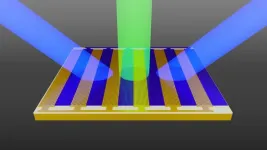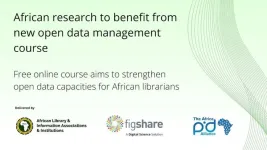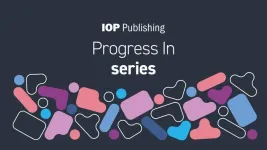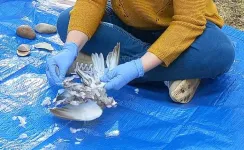(Press-News.org) It is a scene many of us are familiar with: You're working on your laptop at the local coffee shop with maybe a half dozen other laptop users—each of you is trying to load websites or stream high-definition videos, and all are craving more bandwidth. Now imagine that each of you had a dedicated wireless channel for communication that was hundreds of times faster than the Wi-Fi we use today, with hundreds of times more bandwidth. That dream may not be far off thanks to the development of metasurfaces—tiny engineered sheets that can reflect and otherwise direct light in desired ways.
In a paper published today in the journal Nature Nanotechnology, a team of Caltech engineers reports building such a metasurface patterned with miniscule tunable antennas capable of reflecting an incoming beam of optical light to create many sidebands, or channels, of different optical frequencies.
"With these metasurfaces, we've been able to show that one beam of light comes in, and multiple beams of light go out, each with different optical frequencies and going in different directions," says Harry Atwater, the Otis Booth Leadership Chair of the Division of Engineering and Applied Science, the Howard Hughes Professor of Applied Physics and Materials Science, and senior author on the new paper. "It's acting like an entire array of communication channels. And we've found a way to do this for free-space signals rather than signals carried on an optical fiber."
The work points to a promising route for the development of not only a new type of wireless communication channel but also potentially new range-finding technologies and even a novel way to relay larger amounts of data to and from space.
Going beyond conventional optical elements
Co-lead author on the new paper Prachi Thureja, a graduate student in Atwater's group, says to understand their work, first consider the word "metasurface." The root, "meta," comes from a Greek prefix meaning "beyond." Metasurfaces are designed to go beyond what we can do with conventional bulky optical elements, such as camera or microscope lenses. The multilayer transistor-like devices are engineered with a carefully selected pattern of nanoscale antennas that can reflect, scatter, or otherwise control light. These flat devices can focus light, in the style of a lens, or reflect it, like a mirror, by strategically designing an array of nanoscale elements that modify the way that light responds.
Much previous work with metasurfaces has focused on creating passive devices that have a single light-directing functionality that is fixed in time. In contrast, Atwater's group focuses on what are known as active metasurfaces. "Now we can apply an external stimulus, such as an array of different voltages, to these devices and tune between different passive functionalities," says Jared Sisler, also a graduate student in Atwater's lab and co-lead author on the paper.
In the latest work, the team describes what they call a space-time metasurface that can reflect light in specific directions and also at particular frequencies (a function of time, since frequency is defined as the number of waves that pass a point per second). This metasurface device, the core of which is just 120 microns wide and 120 microns long, operates in reflection mode at optical frequencies typically used for telecommunications, specifically at 1,530 nanometers. This is thousands of times higher than radio frequencies, which means there is much more available bandwidth.
At radio frequencies, electronics can easily steer a beam of light in different directions. This is routinely accomplished by the radar navigation devices used on airplanes. But there are currently no electronic devices that can do this at the much higher optical frequencies. Therefore, the researchers had to try something different, which was to change the properties of the antennas themselves.
Sisler and Thureja created their metasurface to consist of gold antennas, with an underlying electrically tunable semiconductor layer of indium tin oxide. By applying a known voltage profile across the device, they can locally modulate the density of electrons in the semiconductor layer below each antenna, changing its refractive index (the material's light-bending ability). "By having the spatial configuration of different voltages across the device, we can then redirect the reflected light at specified angles in real time without the need to swap out any bulky components," Thureja says.
"We have an incident laser hitting our metasurface at a certain frequency, and we modulate the antennas in time with a high-frequency voltage signal. This generates multiple new frequencies, or sidebands, that are carried by the incident laser light and can be used as high-data-rate channels for sending information. On top of this, we still have spatial control, meaning we can choose where each channel goes in space," explains Sisler. "We are generating frequencies and steering them in space. That's the space-time component of this metasurface."
Looking toward the future
Beyond demonstrating that such a metasurface is capable of splitting and redirecting light at optical frequencies in free space (rather than in optical fibers), the team says the work points to several possible applications. These metasurfaces could be useful in LiDAR applications, the light equivalent of radar, where light is used to capture the depth information from a three-dimensional scene. The ultimate dream is to develop a "universal metasurface" that would create multiple optical channels, each carrying information in different directions in free space.
"If optical metasurfaces become a realizable technology that proliferates, a decade from now you'll be able to sit in a Starbucks with a bunch of other people on their laptops and instead of each person getting a radio frequency Wi-Fi signal, they will get their own high-fidelity light beam signal," says Atwater, who is also the director of the Liquid Sunlight Alliance at Caltech. "One metasurface will be able to beam a different frequency to each person."
The group is collaborating with the Optical Communications Laboratory at JPL, which is working on using optical frequencies rather than radio frequency waves for communicating with space missions because this would enable the ability to send much more data at higher frequencies. "These devices would be perfect for what they're doing," says Sisler.
The new paper, "Electrically tunable space-time metasurfaces at optical frequencies," appears in the July 24 issue of the journal Nature Nanotechnology. Additional authors on the paper include Meir Y. Grajower, a former postdoctoral scholar research associate in Atwater's group; Ruzan Sokhoyan, a nanophotonics research scientist at Caltech; and Ivy Huang, a former Summer Undergraduate Research Fellowship student in Atwater's group. The work was supported by the Air Force Office of Scientific Research Meta-Imaging, DARPA EXTREME MURI, the Natural Sciences and Engineering Research Council of Canada, and Meta Platforms, Inc.
END
Nanoscale device simultaneously steers and shifts frequency of optical light, pointing the way to future wireless communication channels
2024-07-24
ELSE PRESS RELEASES FROM THIS DATE:
African research to benefit from new open data management course
2024-07-24
Open data practices in African research institutions will be bolstered thanks to a new online course for librarians to coincide with International Open Access Week (21-27 October 2024).
The Open Data Management Foundational Course – to be offered entirely free over four weeks by open data experts – is a direct response to calls to strengthen the research data management capacity of librarians in Africa.
The course will be facilitated by AfLIA, the African Library and Information Associations and Institutions, as part of an ongoing collaboration ...
IOP Publishing extends scope of Progress in Energy as part of prestigious new journal series
2024-07-24
IOP Publishing (IOPP) is extending the remit of its journal Progress in Energy by accepting high-impact original research articles alongside its well-recognised review programme. Progress in Energy is part of a developing new Progress In series™, that builds on the reputation of IOPP’s prestigious journal Reports on Progress in Physics and is designed to unite communities looking to advance and explore progressive research across the physical sciences.
Progress in Energy is a highly selective, multidisciplinary journal with a mission to publish groundbreaking ...
Researchers record first-ever images and data of a shark experiencing a boat strike
2024-07-24
NEWPORT, Ore. – Hours after tagging an endangered basking shark off the coast of Ireland in April, researchers captured what they believe is the first ever video of a shark or any large marine animal being struck by a boat.
The data, collected by an activity measurement device similar to a FitBit and a connected camera, provided scientists a unique opportunity to learn more about the impact of vessel strikes on large marine animals, which is a rising concern around the globe, said Taylor Chapple, a shark researcher at Oregon State University’s Hatfield ...
Can anxiety increase the risk of developing dementia?
2024-07-24
In a study published in the Journal of the American Geriatrics Society, both chronic and new anxiety were associated with an increased risk of dementia. However, where anxiety had resolved, there was no association with dementia risk.
The study included 2,132 individuals with an average age of 76 years who were participating in the Hunter Community Study in Australia and who were followed for an average of 10 years. The presence of chronic anxiety and new onset anxiety were associated with 2.8- and 3.2-times higher risks of having dementia, respectively. Even ...
Could Botox make walking easier in children with cerebral palsy?
2024-07-24
A recent randomized clinical trial published in Developmental Medicine & Child Neurology assessed whether injections of botulinumtoxin-A in calf muscles benefit children with cerebral palsy.
“We hypothesized that injections with botulinumtoxin-A in the calf muscles would make walking easier, caused by improved ankle joint functioning following spasticity reduction,” the authors wrote.
In the trial, one botulinumtoxin-A treatment was not superior to placebo in making walking easier (measured as a reduction in energy cost or improved walking capacity); however, there was some evidence of a delayed improvement in energy cost. Moreover, there was some evidence of a decrease ...
How is biodiversity changing in one of the world’s most productive ocean ecosystems?
2024-07-24
In research published in Global Change Biology, investigators examined DNA within ocean bottom sediment cores to assess changes in living organisms within one of the world’s most productive marine ecosystems: the Atacama Trench in the eastern Pacific Ocean, which is located about 100 miles off the coast of Peru and Chile and lies at a depth of up to 5 miles below the surface.
The study is important because ecosystems around the Atacama Trench have been intensively fished and are affected by climate change. Analyses showed a severe drop in biodiversity from 1970 to 1985 that aligns with one of the strongest known El Niño events, as well as extensive fishing efforts in the ...
How does a common skin bacterium cause chronic infections after orthopedic surgeries?
2024-07-24
In individuals who have undergone knee or hip replacement surgery, clinicians are noticing increasing numbers of chronic bone infections linked to a bacterial strain commonly found on the skin. A new study published in the Journal of Orthopaedic Research provides insights into the mechanisms involved.
Utilizing mouse models of bone infection and systematic electron microscopy studies, scientists found that the common skin bacteria Cutibacterium acnes can persist as layers of biofilms for weeks on contaminated titanium or stainless-steel implants. It can also invade ...
Have the burdens of childhood mental health conditions changed over time in England?
2024-07-24
Surveys conducted in England in 1999, 2004, and 2017 have revealed that children with a psychiatric disorder in 2017 experienced more severe difficulties and greater impacts on functioning at school, home, and in their daily lives, compared with children with a disorder in earlier decades. The findings come from a study published in the Journal of Child Psychology and Psychiatry.
The study used data from interviews and questionnaires completed by parents, children (if they were aged ≥ 11 years), and teachers across all 3 surveys.
The increased difficulties found in the study were ...
How to eliminate racial disparities in colon cancer
2024-07-24
A new paper in the Journal of the National Cancer Institute, published by Oxford University Press, finds that eliminating the race disparity in colon cancer testing in the United States would reduce colon cancer, and colon cancer death rates, dramatically among Black people.
Colorectal cancer rates and deaths from the disease have decreased over time, but racial disparities remain and are significant. Compared to White Americans, Black Americans experience higher rates of colorectal cancer incidence and lower survival rates. Black adults are approximately 23% more likely to receive a colorectal cancer diagnosis than White adults. They are also about 31% more likely to ...
Cook like a Neanderthal: Scientists try to replicate ancient butchering methods to learn how Neanderthals ate birds
2024-07-24
It's hard to know what Neanderthals ate: food preparation, especially when it comes to smaller items like birds, can leave few archaeological traces. But understanding their diets is critical to understanding these incredibly adaptable hominins, who thrived for hundreds of thousands of years in wildly varied environments. To learn what food preparation could look like in the archaeological record, scientists tried cooking like Neanderthals.
“Using a flint flake for butchering required significant precision and effort, which we had not fully valued before this experiment,” said Dr Mariana Nabais of the Institut ...




